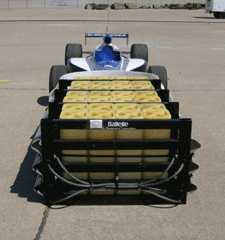Self-Healing Guardrails
The United States may soon need to bid a sad farewell to the sand-barrel approach to highway crash protection. A new self-healing automotive crash-barrier material developed to add safety at NASCAR pit stops–it recaptures its original shape minutes after a car crashes into it–is now under evaluation for use on the nation’s highways.

“If we put these in high-accident locations, it’s immediately ready after an accident” to absorb a second crash, says Dean Focke, roadway standards engineer for the Ohio Department of Transportation, which, along with federal transportation officials, is currently evaluating the material, made by Battelle Science and Technology, of Columbus, OH.
The material is a type of polyurethane that Battelle developed through a proprietary process that removes brittleness no matter how hard or fast it’s deformed. What’s more, the deformed material doesn’t “rebound” too quickly, which could cause a crashed car to bounce back into lanes of traffic. The materials can be arranged in several bays and modified for various applications.
“Most materials, as you impact it at faster and faster rates, they will have more brittleness,” says Jay Sayre, a materials scientist at Battelle. “But this material doesn’t go through a brittle failure. It’s an energy-absorbing hyperelastic form of polyurethane. What’s unique about it is the mechanical performance.”
Battelle originally developed the system for NASCAR, which wanted something practical and safe for the leading edge of the concrete wall that separates pit row from the race lanes. A prototype was able to take head-on and 20-degree impacts at speeds up to 100 miles per hour and still regain its shape. Now Battelle is working on versions that could take the place of highway-crash barriers and even some military armor applications.
With most polyurethanes and other plastics, “if you hit it, it might go back to 95 percent the first time, 90 percent the second time, 85 percent, and eventually, it just doesn’t go back,” says Scott Versluis, vice president for technology development and commercialization at Battelle. “That’s how a classical plastic behaves. Also, there is a point where you can stretch it far enough that it will break.”
But Versluis says that the new polyurethane has been tested “a dozen times with vehicle impacts–with NASCAR vehicles and with three-quarter-ton pickup trucks. And after a dozen impacts, we still don’t see a change. It takes a few minutes to get back to its original configuration. After ten minutes, you see 98 percent; after 30 minutes, it’s back to the original.”
Focke says the material could have some practical advantages for places like bridge abutments and concrete barriers that separate lanes of traffic. “For some reason or another, people tend to go straight at those things,” he says. And today’s technologies–sand- or water-filled barrels; steel cages with plastic boxes that crush–are essentially one-time-use systems. Once they are destroyed, they need to be replaced.
“It could be days or weeks before some states can get out to repair these sites,” Focke says. “Even here in Ohio it can take up to two weeks to repair, and if you get 100,000 vehicles a day, there’s a chance that another crash can happen before we get back out there. And it exposes the workers to danger during the repair.”
Versluis says two companies that manufacture highway safety barriers have licensed the technology, and that it is now under evaluation by the Federal Highway Safety Administration. The evaluations are expected to be complete within a couple of months. Battelle hopes to have a product on the market by summer 2007.
Keep Reading
Most Popular
Large language models can do jaw-dropping things. But nobody knows exactly why.
And that's a problem. Figuring it out is one of the biggest scientific puzzles of our time and a crucial step towards controlling more powerful future models.
How scientists traced a mysterious covid case back to six toilets
When wastewater surveillance turns into a hunt for a single infected individual, the ethics get tricky.
The problem with plug-in hybrids? Their drivers.
Plug-in hybrids are often sold as a transition to EVs, but new data from Europe shows we’re still underestimating the emissions they produce.
Stay connected
Get the latest updates from
MIT Technology Review
Discover special offers, top stories, upcoming events, and more.